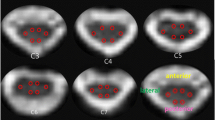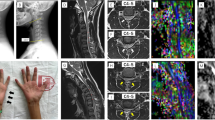Abstract
Purpose
To explore the changes in diffusion tensor imaging (DTI) parameters in cervical spinal cord in Hirayama disease (HD) patients and healthy volunteers and to compare these parameters between cervical flexion and neutral positions in HD patients.
Methods
Seventeen male patients with HD and eleven healthy young males were included to receive DTI scans in cervical flexion and neutral positions. The FA and ADC values of different levels were measured based on the region of interest drawn on the mid-sagittal plane. The dynamic compressed level’s parameters were defined as the lowest and the second lowest FA and the highest and the second highest ADC, respectively. The clinical assessment of patients was obtained using their disabilities of the arm, shoulder and hand (DASH) scores.
Results
For the HD patients, the FA values in the cervical flexion position were lower and the ADC values were much higher than those in the cervical neutral position. Compared with the controls, the ADC values were significantly higher in the lower levels (C5/6-C7/T1) and the FA values obviously lower at C7/T1 in HD patients in cervical neutral position. The FA and ADC values of the dynamic compressed level in HD patients deviated significantly from the average of the lower levels in controls. Both the FA and ADC values of the dynamic compressed level correlated with the DASH scores (FA, R2 = 0.520, P = 0.001; ADC, R2 = 0.421, P = 0.005).
Conclusions
DTI parameters can support a hypothesis of dynamic cervical flexion compression and noninvasively reveal the neural status of HD patients.
Graphical abstract
These slides can be retrieved under Electronic Supplementary Material.





Similar content being viewed by others
References
Hirayama K (2000) Juvenile muscular atrophy of distal upper extremity (Hirayama disease): focal cervical ischemic poliomyelopathy. Neuropathology 20(suppl):S91–S94
Huang YC, Ro LS, Chang HS, Chen CM, Wu YR, Lee JD, Lyu RK (2008) A clinical study of Hirayama disease in Taiwan. Muscle Nerve 37(5):576–582
Zhou B, Chen L, Fan D, Zhou D (2010) Clinical features of Hirayama disease in mainland China. Amyotroph Lateral Scler 11(1–2):133–139
Tashiro K, Kikuchi S, Itoyama Y, Tokumaru Y, Sobue G, Mukai E, Akiguchi I, Nakashima K, Kira J, Hirayama K (2006) Nationwide survey of juvenile muscular atrophy of distal upper extremity (Hirayama disease) in Japan. Amyotroph Lateral Scler 7(1):38–45
Pradhan S (2009) Bilaterally symmetric form of Hirayama disease. Neurology 72(24):2083–2089
Kang JS, Jochem-Gawehn S, Laufs H, Ferbert A, Vieregge P, Ziemann U (2011) Hirayama disease in Germany: case reports and review of the literature. Nervenarzt 82(10):1264–1272
Andreadou E, Christodoulou K, Manta P, Karandreas N, Loukaidis P, Sfagos C, Vassilopoulos D (2009) Familial asymmetric distal upper limb amyotrophy (Hirayama disease): report of a Greek family. Neurologist 15(3):156–160
Paredes I, Esteban J, Ramos A, Gonzalez P, Rivas JJ (2014) A severe case of Hirayama disease successfully treated by anterior cervical fusion. J Neurosurg Spine 20(2):191–195
Lewis D, Saxena A, Herwadkar A, Leach J (2017) A confirmed case in the United Kingdom of Hirayama Disease in a young white male presenting with hand weakness. World Neurosurg 105:1039.e7–1039.e12
Kieser DC, Cox PJ, Kieser SCJ (2018) Hirayama disease. Eur Spine J 27(6):1201–1206
Zheng C, Zhu D, Lu F, Zhu Y, Ma X, Xia X, Jiang J (2017) A double determination of central motor conduction time in the assessment of Hirayama disease. Clin Neurophysiol 128(11):2369–2374
Lai V, Wong YC, Poon WL, Yuen MK, Fu YP, Wong OW (2011) Forward shifting of posterior dural sac during flexion cervical magnetic resonance imaging in Hirayama disease: an initial study on normal subjects compared to patients with Hirayama disease. Eur J Radiol 80(3):724–728
Lehman VT, Luetmer PH, Sorenson EJ, Carter RE, Gupta V, Fletcher GP, Hu LS, Kotsenas AL (2013) Cervical spine MR imaging findings of patients with Hirayama disease in North America: a multisite study. AJNR Am J Neuroradiol 34(2):451–456
Song J, Wang HL, Zheng CJ, Jiang JY (2017) Risk factors for surgical results of Hirayama disease: a retrospective analysis of a large cohort. World Neurosurg 105:69–77
Wang H, Sun C, Yang S, Jiang J, Lu F, Ma X, Xia X (2018) Dynamic cervical radiographs in patients with Hirayama disease: an unneglectable factor on the choice of surgery options. World Neurosurg 114:e433–e440
Zheng C, Nie C, Lei W, Zhu Y, Zhu D, Wang H, Lu F, Weber R, Jiang J (2018) CAN anterior cervical fusion procedures prevent the progression of the natural course of Hirayama disease? An ambispective cohort analysis. Clin Neurophysiol 129(11):2341–2349
Lu F, Wang H, Jiang J, Chen W, Ma X, Ma X, Xia X, Wang L (2013) Efficacy of anterior cervical decompression and fusion procedures for monomelic amyotrophy treatment: a prospective randomized controlled trial. J Neurosurg Spine 19(4):412–419
Wang HL, Wu YW, Song J, Jiang JY, Lu FZ, Ma XS, Xia XL (2018) Cortical activation changes in Hirayama disease after anterior cervical decompression and fusion. World Neurosurg 116:e588–e594
Wang X, Wang H, Sun C, Zhou S, Meng T, Lv F, Ma X, Xia X, Jiang J (2018) Analysis of radiological parameters associated with decreased fractional anisotropy values on diffusion tensor imaging in patients with lumbar spinal stenosis. Eur Spine J. https://doi.org/10.1007/s00586-018-5562-8
Song T, Chen WJ, Yang B, Zhao HP, Huang JW, Cai MJ, Dong TF, Li TS (2011) Diffusion tensor imaging in the cervical spinal cord. Eur Spine J 20(3):422–428
Lee JW, Kim JH, Park JB, Park KW, Yeom JS, Lee GY, Kang HS (2011) Diffusion tensor imaging and fiber tractography in cervical compressive myelopathy: preliminary results. Skelet Radiol 40(12):1543–1551
Jones JG, Cen SY, Lebel RM, Hsieh PC, Law M (2013) Diffusion tensor imaging correlates with the clinical assessment of disease severity in cervical spondylotic myelopathy and predicts outcome following surgery. AJNR Am J Neuroradiol 34(2):471–478
Boelmans K, Kaufmann J, Schmelzer S, Vielhaber S, Kornhuber M, Münchau A, Zierz S, Gaul C (2013) Hirayama disease is a pure spinal motor neuron disorder—a combined DTI and transcranial magnetic stimulation study. J Neurol 260(2):540–548
MacDermid JC, Kramer JF, Woodbury MG, McFarlane RM, Roth JH (1994) Interrater reliability of pinch and grip strength measurements in patients with cumulative trauma disorders. J Hand Ther 7(1):10–14
Ghosh PS, Moodley M, Friedman NR, Rothner AD, Ghosh D (2011) Hirayama disease in children from North America. J Child Neurol 26(12):1542–1547
Rajasekaran S, Yerramshetty JS, Chittode VS, Kanna RM, Balamurali G, Shetty AP (2014) The assessment of neuronal status in normal and cervical spondylotic myelopathy using diffusion tensor imaging. Spine (Phila Pa 1976) 39(15):1183–1189
Kuhn FP, Feydy A, Launay N, Lefevre-Colau MM, Poiraudeau S, Laporte S, Maier MA, Lindberg P (2016) Kinetic DTI of the cervical spine: diffusivity changes in healthy subjects. Neuroradiology 58(9):929–935
Acknowledgements
We gratefully thank all the participants in this research study together with our technicians for their dedicated efforts in scanning standardization and quality assurance. This work was supported by Shanghai Municipal Science and Technology Commission (16411964100), Youth Science Project of National Natural Science Foundation of China (81501909), and National Natural Science Foundation of China (81772388).
Funding
This study was funded by Science and Technology Commission of Shanghai Municipality (16411964100), National Natural Science Foundation of China (81501909), and National Natural Science Foundation of China (81772388).
Author information
Authors and Affiliations
Corresponding authors
Ethics declarations
Conflict of interest
None of the authors have any potential conflict of interest.
Human and animal right
We declare that all human and animal studies have been approved by university and hospital and have therefore been performed in accordance with the ethical standards laid down in the 1964 Declaration of Helsinki and its later amendments.
Informed consent
Informed consent was obtained from all individual participants included in the study.
Additional information
Publisher's Note
Springer Nature remains neutral with regard to jurisdictional claims in published maps and institutional affiliations.
Electronic supplementary material
Below is the link to the electronic supplementary material.
Rights and permissions
About this article
Cite this article
Sun, C., Zhou, S., Cui, Z. et al. The evaluation on neural status of cervical spinal cord in normal and Hirayama disease using diffusion tensor imaging. Eur Spine J 28, 1872–1878 (2019). https://doi.org/10.1007/s00586-019-06013-1
Received:
Revised:
Accepted:
Published:
Issue Date:
DOI: https://doi.org/10.1007/s00586-019-06013-1




